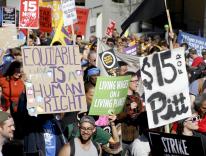On November 12, 1936, three welders at a General Motors plant in Flint, Michigan, sat down on the job. They were protesting deadly working conditions, below-subsistence wages, and relentless anti-union intimidation tactics, including an illegal network of spies so extensive that GM even spied on its own spies. The welders were fired, but in response, seven hundred more workers sat down on the job. What followed was a wave of sit-down strikes at GM, which led to a $25 million wage increase and recognition of the United Auto Workers (UAW).
Current UAW president Shawn Fain—elected in March as a reform candidate after years of corruption and concessions at the union—evoked this past when he announced a “stand-up strike” on September 14. “In the spirit of the sit-down strike,” he said, “the stand-up strike will keep the companies guessing.” In practice, this means workers are striking strategically at select plants of the “Big Three” major car manufacturers, GM, Ford, and Stellantis—the first time there have been walkouts at all three simultaneously. Fain’s hope is that this limited strike can target vulnerable points in the automakers’ production system while reducing the burden on UAW’s strike fund. That said, an all-out work stoppage remains on the table.
The UAW’s central grievances revolve around concessions the union made to car companies in 2008 in order to ease their financial difficulties and facilitate a taxpayer-funded bailout. These concessions amounted to billions in reduced labor costs and included layoffs; benefit reductions; and wage cuts, freezes, and tiers, which mean newer workers make less. As a result, since 2003, autoworkers’ inflation-adjusted average hourly wage is down by 30 percent. In addition to regular cost-of-living adjustments and an end to tiers, the UAW is asking for a 36 percent pay increase over four years (down from an initial ask of 46 percent).
The automakers can afford it. Big Three profits are up 65 percent over the last four years, and GM CEO Mary Barra took home $29 million in 2022, 362 times the pay of a median GM employee. Automakers are pleading that they need cash on hand to finance the transition to electric vehicles and compete with non-union automakers, but in the past few years they’ve wasted billions on stock buybacks, which boost stock prices and enrich shareholders. Illegal before 1982, buybacks were a central factor leading to GM’s 2009 bankruptcy.
The UAW supports EV production but insists “on a just transition that ensures auto workers have a place in the new economy.” Because new battery plants have been structured as joint ventures with Chinese and South Korean companies, the Big Three can avoid abiding by the UAW contract. But the union has been trying to organize workers at these plants, as well as at Tesla and other EV manufacturers. Fain has criticized the Biden administration for not tying EV subsidies in the Inflation Reduction Act to worker protections. GM expects to collect $300 million in EV tax credits this year, but workers at its Ohio battery plant were making just $16.50 an hour while facing a range of safety hazards.
The strike is following a now-familiar pattern. As with the ongoing writers’ strike in Hollywood and the foiled rail strike last year, labor is resisting capital’s use of technological shifts and financialization to further prioritize short-term profits and stock performance over worker compensation and safety. These corporate priorities also tend to destabilize the economy over the long term. Despite worries that strikes will crash the economy, they represent a much-needed site of resistance to an economy designed to make the rich richer no matter the cost.
Please email comments to [email protected] and join the conversation on our Facebook page.
Previous Story
A Church Against Science?
Next Story
Letters | Fighting featureless modernity, helping young people find Christ


